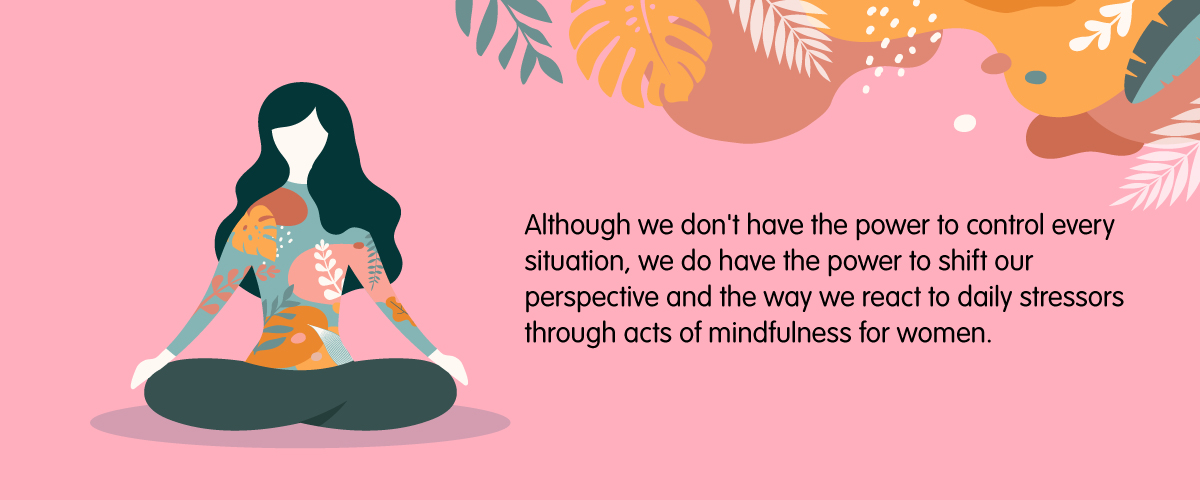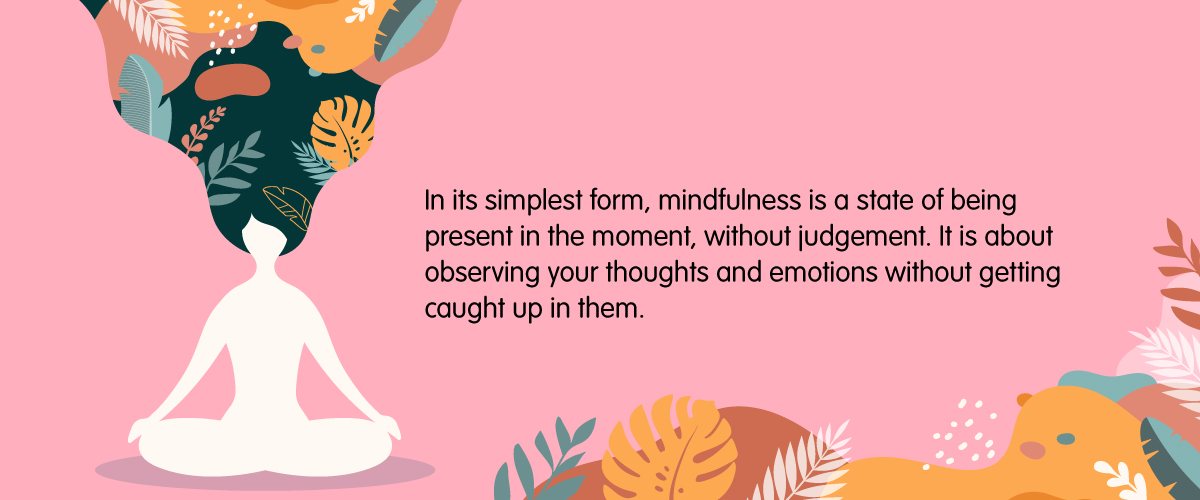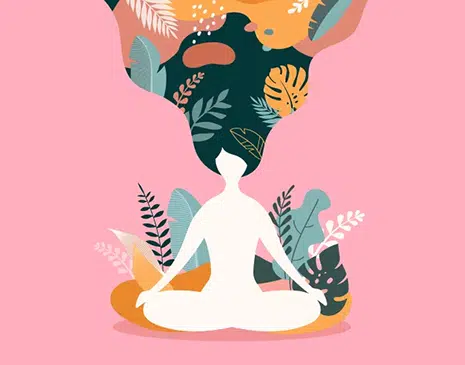Wise and practical guidance to help return to the present moment
As a woman, it’s common to find yourself striving for excellence in your career, health, relationships, and personal development. When you add to the mix the societal pressures of modern-day living, it’s fair to admit there are often too many balls in the air when attempting to juggle the demands of everyday life.
Amongst the chaos we know as adult life, it’s easy to fall into the hamster wheel of prioritising habitual tasks of busyness over mindfulness-based approaches, despite knowing the benefits of mindfulness in making you feel happier, calmer, and more connected.
And, although we don’t have the power to control every situation, we do have the power to shift our perspective and the way we react to daily stressors through acts of mindfulness for women.

What is mindfulness?
Mindfulness is a word that’s thrown around a lot these days, and it can mean different things to different people. In its simplest form, mindfulness is a state of being present in the moment, without judgement. It is about observing your thoughts and emotions without getting caught up in them.
It’s common for people to look to the past or the future for change, happiness, and a greater sense of contentment. However, the past is already gone, and the future is yet to happen. There is no way of changing the past, and there is no way to predict the future. In cultivating awareness of your present moment – which is the only moment you are ever in control – you can shape your actions and reactions.
Mindfulness is about living in the now, developing an awareness of your surroundings, and being less reactive to daily happenings. It is not about clearing your mind – that is impossible. Rather, it’s about learning how to observe your thoughts and let them appear and disappear without forming an attachment to them.
What are the benefits of mindfulness?
A little mindfulness goes a long way. By implementing a regular mindfulness practice, you open yourself up to the benefits of:
- Decreased symptoms of anxiety and stress
- Decreased symptoms of depression, exhaustion, and irritability
- Decreased reactivity to situations
- Improved emotional regulation
- Improved general well-being
- Better sleeping patterns
- Improved memory and cognitive abilities
- Greater sense of self-compassion
- Improved management of chronic pain
- Feelings of contentment and happiness in your own skin

How to practice mindfulness for women
Mindfulness can be practiced anytime, anywhere, and by anyone. If you’re an absolute beginner, or you’re struggling to squeeze a little mindfulness into everyday life, it may be beneficial to find an organisation offering mindfulness-based classes to help motivate you and keep you on track to develop an ongoing habit.
Otherwise, if you find yourself feeling stressed, overwhelmed, distracted, or a combination of all three, bring mindfulness into your life with these simple practices of mindfulness for women.
Mindfulness meditation
Stuck in a funk? Feeling anxious or agitated? Evidence shows that meditation may help to decrease anxiety, especially in individuals living with high anxiety.
To implement a regular meditation practice in your life, follow these steps:
- Set up a comfortable space in a quiet, calm area of your home or garden.
- If you prefer to meditate to background music, select whichever meditation track suits the vibe you’re aiming for.
- Take a comfortable seat and close down your eyes.
- Move your focus to your natural breath – your inhale and your exhale.
- Pay attention to the way your chest rises and falls with each breath.
- Then, simply observe your thoughts as they arrive and pass. Don’t try to stop or change them, just let them be.
You can practice mindfulness meditation for as long as you like. But even a few minutes of mindfulness can lead to a more free and relaxed mind. You may even wish to seek out lessons from an experienced meditation teacher in your area. Someone who has taught meditation for several years will provide great benefits in achieving the personal goals you wish to achieve through meditation.

Embrace deep belly breathing
It’s normal for time-pressed women to experience stress regularly. When living in a constant state of stress, breathing tends to become shallow and fast. Through the practice of mindful breathing, you can slow down and deepen your breathing, which in turn can help to make you feel more centred and calm.
Mindful breathing is a great way to reduce anxiety, stress, depression, exhaustion, and irritability. Simply take a comfortable seated position, relax your shoulders while maintaining a tall spine, and focus on inhaling air into the lower lungs, expanding your belly. Then slowly exhale the air from your belly before returning for another round of inhalation. Repeat this pattern for longer periods of 5 to 10 minutes. Try placing your hand on your abdomen to help guide your breath if you are finding it hard to breathe deeply enough.
Practice gratitude
It can be easy to forget to be grateful for the good things in life when you’re feeling stressed or down. Practicing gratitude is one simple practice to help you feel happier and more resilient. It’s completely true; practicing gratitude can make you happier.
Consider the following tips as your practical guide on how to use mindfulness to practice gratitude in everyday life:
- Pay attention to the small things
It’s easy to take the good things in life for granted. Mindfulness can help you to become more present and aware of the good things in life by bringing your attention to noticing and appreciating them.
- Be thankful for what you have
By taking the time to be thankful for what you do have, you can cultivate a greater sense of contentment.
- Let go of negativity
Mindfulness is a potent antidote to negativity, helping you to let go of negative thoughts by shifting your focus on to the present moment.
- Be kind to yourself
In the theme of compassion-based approaches, it’s important to be kind to yourself and others. Showing yourself compassion can help you to feel more happier and grateful for the life you have.
- Keep a gratitude journal
Keeping a daily gratitude journal may seem time-consuming at first, but by writing down the things in your life that you’re grateful for, you make these things more visible.
- Share your gratitude with others
In true domino style, sharing your gratitude with the people in your life can help them to feel more grateful, too. You could write a thank-you note, say something nice to someone, or even just share a smile with a stranger passing by.

Set a morning mantra
A mantra is a short intention-fuelled statement with the power to create internal and external change when repetitively recited. By setting a daily mantra when you wake up each day, you’re setting the tone for your day, and bound to start the day on a good note.
Aim to keep your morning mantra light, fun, and upbeat. If you’re stuck for ideas, try these on for size:
“I attract great things into my life”
“I am worthy just as I am”
“I choose to forgive and let go of anger”
“I focus on what I can do, not what I cannot do”
“I radiate and attract positive energy”

Walk in nature
Being in nature and observing your surroundings can help to ground you in the present moment and make you feel more connected to the world around you. Plus, being outdoors is incredibly relaxing. So, make an effort to get outdoors and smell the flowers, gaze at the clouds, and smother your feet in the lush grass.
Ways to practice mindfulness in nature, include walking mindfully through a park, meditating by the ocean, and simply observing the natural beauty of your neighbourhood.







